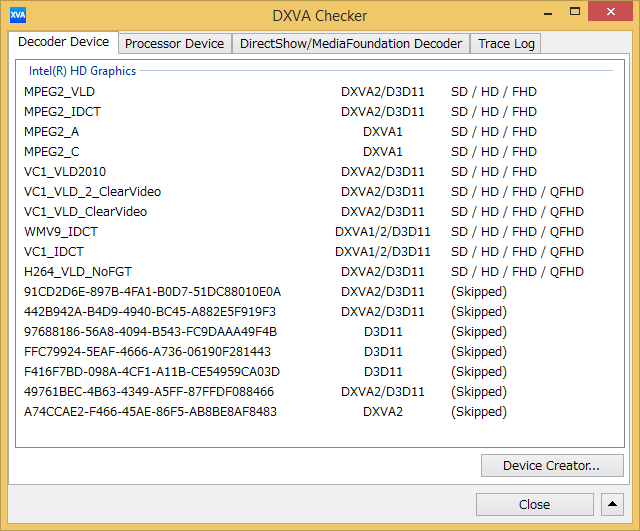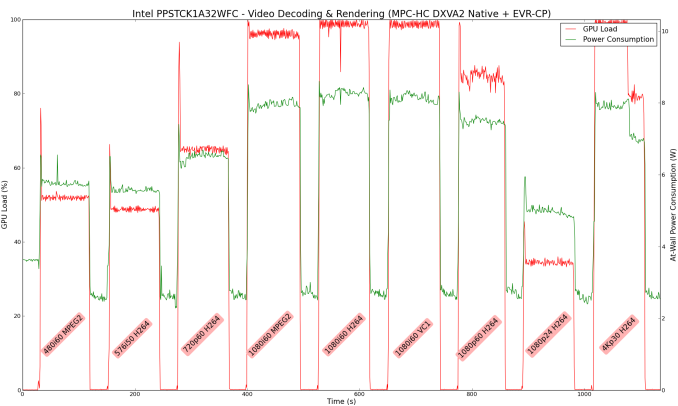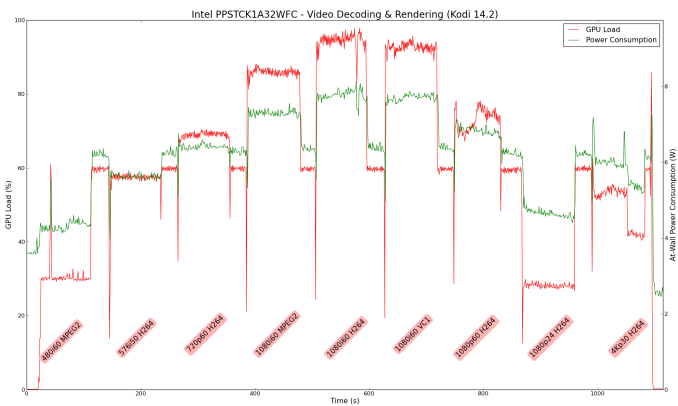Intel PPSTCK1A32WFC Bay Trail-T Compute Stick Review
by Ganesh T S on April 22, 2015 11:00 AM EST- Posted in
- Systems
- Intel
- Bay Trail
- HDMI Stick
HTPC Credentials
Usage of the Compute Stick as an entertainment platform is promoted by Intel as one of the use-cases. It is a bit surprising (given the form factor) that the Compute Stick has a fan. Subjectively, I was not comfortable with the acoustics in a 'office scenario' with the Compute Stick at the base of the monitor (connected via the HDMI extender cable) and myself seated around 70 cms. from it. The small diameter of the fan makes for a whining high-pitched noise, and it is compounded by the fact that it starts and stops depending on the SoC load.
Objectively speaking, Intel provided an acoustics rating of 28 dB at 1m distance for the noisiest mode. If the Compute Stick were to be hidden behind the TV, it is unlikely that users can hear such low noise at typical television viewing distances. It is not ideal, but Intel indicated that the performance of the device needs proper thermals. In order to to balance the very small size along with overall cost and performance, they went with a small fan as the optimal thermal solution. Now that we have got the acoustics out of the way, let us move on to the other HTPC aspects.
Refresh Rate Accurancy
Starting with Haswell, Intel, AMD and NVIDIA have been on par with respect to display refresh rate accuracy. The most important refresh rate for videophiles is obviously 23.976 Hz (the 23 Hz setting). The Intel PPSTCK1A32WFC has no trouble with refreshing the display appropriately in this setting, but it is not as accurate as Haswell or Broadwell or even other Bay Trail-based systems (refreshing at 23.973 Hz instead of 23.976 Hz).
The gallery below presents some of the other refresh rates that we tested out. The first statistic in madVR's OSD indicates the display refresh rate.
Network Streaming Efficiency
Evaluation of OTT playback efficiency was done by playing back our standard YouTube test stream and five minutes from our standard Netflix test title. Using HTML5, the YouTube stream plays back a 720p encoding. Since YouTube now defaults to HTML5 for video playback, we have stopped evaluating Adobe Flash acceleration. Note that only NVIDIA exposes GPU and VPU loads separately. Both Intel and AMD bundle the decoder load along with the GPU load. The following two graphs show the power consumption at the wall for playback of the HTML5 stream in Mozilla Firefox (v 37.0.1).

GPU load was around 51.56% for the YouTube HTML5 stream and 4.53% for the steady state 6 Mbps Netflix streaming case. Mozilla Firefox is terribly inefficient in terms of power for YouTube playback. The same test stream, when played back in Internet Explorer, consumed only 3.55 W on an average and had a GPU load of 9.1% for the same H.264 stream.
Netflix streaming evaluation was done using the Windows 8.1 Netflix app. Manual stream selection is available (Ctrl-Alt-Shift-S) and debug information / statistics can also be viewed (Ctrl-Alt-Shift-D). Statistics collected for the YouTube streaming experiment were also collected here. The power efficiency of the Compute Stick platform comes to the fore here.

Decoding and Rendering Benchmarks
The form factor of the Compute Stick and the internal components make it clear that consumers are not going to play back videos using the madVR renderer. Instead, it is highly likely that Kodi will be used as the interface for media playback. We evaluated performance under MPC-HC + EVR-CP and Kodi 14.2 for our test suite. Prior to those results, let us take a look at the codecs that are hardware-accelerated by the Bay Trail-T SoC.
As expected, we have acceleration for MPEG-2, VC1, WMV9 and H.264. HEVC is not necessary for such a platform at this point in time.
In our earlier reviews, we focused on presenting the GPU loading and power consumption at the wall in a table (with problematic streams in bold). Starting with the Broadwell NUC review, we decided to represent the GPU load and power consumption in a graph with dual Y-axes. Nine different test streams of 90 seconds each were played back with a gap of 30 seconds between each of them. The characteristics of each stream are annotated at the bottom of the graph. Note that the GPU usage is graphed in red and needs to be considered against the left axis, while the at-wall power consumption is graphed in green and needs to be considered against the right axis.
Frame drops are evident whenever the GPU load consistently stays above the 85 - 90% mark. In addition to tracking that aspect in the graphs below, we also get an idea of the system's power efficiency for decode and playback of some common codecs.
The above graph suggests that the Compute Stick is likely to drop frames when deinterlacing of high frame rate content is required. It is possible that EVR, the native renderer, will perform better than EVR-CP.
Kodi doesn't deinterlace content by default - so, the GPU load goes unreasonably high only for the 1080i60 stream. Another aspect to observe with Kodi is that 'idling' at the XBMC interface consumes around 60% of the GPU resources and the power penalty is around 6 W. Depending on the codec and frame rate, the GPU load and power consumption might be lower or higher than the 'idle' state. For example, 480i60 and 1080p24 videos play back within the 5 W power envelop.
Note on HD Audio Bitstreaming
As of April 2015, the Intel graphics drivers for Bay Trail-T (32-bit) have support only for bitstreaming of DTS, Dolby Digital and Dolby Digital Plus. This means that Netflix and other similar OTT sites are in the clear. However, users hoping to take advantage of lossless HD audio in Blu-ray backups are going to be disappointed. In any case, streaming of Blu-rays over a 802.11n Wi-Fi network will result in a bad user experience. So, it is possible that the absence of HD audio bitstreaming will not bother too many consumers.



















103 Comments
View All Comments
uzm - Wednesday, April 22, 2015 - link
can it output 4K desktop? I'm looking for something that can drive an image slideshow on a 4K TV.zeo - Monday, April 27, 2015 - link
Probably better off considering something like the Surface 3 with Cherry Trail, the new Gen 8 GPU is significantly better than Bay Trail's Gen 7 GPU and the display port should easily handle a 4K display better than most models with HDMI output...Bansaku - Wednesday, April 22, 2015 - link
I wonder if you could Hackintosh it?azazel1024 - Wednesday, April 22, 2015 - link
I don't know how that can be considered an effective thermal solution. Maybe it is how tiny the chasis is. In my T100 with the z3740 (and plastic chasis, but obviously a larger chasis than the compute stick, but the compute stick has active cooling), I hit 1.83-1.86GHz and the CPU will stay pegged there under max load. I don't think I've ever monitored it for more than ~10 minutes, but running handbrake on it to test, it loaded all 4 cores at 95-99% and over the course of 10 minutes it never dropped the CPU frequency below that 1.83-1.86GHz range.The brief bit of testing (VERY brief) running some games (Kerbal space program actually) my T100 runs (after a minute or two to settle the thermals) the CPU at 1.33-1.6GHz generally and the GPU at around 450MHz or so with some brief bursts on both up towards 1.7GHz and 650MHz respectively.
Also 8w sounds like a LOT of power. Back to the whole KSP thing, I can get a little over 5 hours of battery life on my T100 running KSP, which is on a 31hwr battery, which equates to about 6 watts of average consumption under heavy CPU and GPU load (okay, probably not be as high as prime + furmark) for the ENTIRE platform, SoC, memory, screen, keyboard dock, etc. I'd be shocked if the SoC itself was drawing more than 4w.
ganeshts - Wednesday, April 22, 2015 - link
For this chassis size, I will call the thermal solution effective since the CPU is running at the rated 1.3 GHz without throttling for more than 30 minutes, all the while maintaining the temperature below 85 C for the CPU package. The only time I would call a thermal solution ineffective is if it allows the CPU to reach junction temperature or makes the CPU run at less than rated speed.azazel1024 - Thursday, April 23, 2015 - link
I guess that is a point, but since it seems to throttle within just a couple of seconds back towards or to base clock, I think I'd call that thermal solution marginal. Does the processor melt down or throttle below base clock? No, but at the same time, the turbo core speeds seem close to worthless, because only occasionally would you ever see them.At least something that can manage to hit max turbo for 10-20s, you would likely see real benefits of that in a lot of light work loads, but here you'd only get to experience it for very, very brief periods of time (perhaps a webpage load, but you aren't going to see it in an application load even).
zodiacfml - Wednesday, April 22, 2015 - link
Pricey but its probably tested to run 24 7 on a display for ads....than cheaper intel windows tablets. Id reccomend this at my work.valnar - Wednesday, April 22, 2015 - link
The WiFi speed is barely adequate, and that is only 20' away. Given the single radio, any issues whatsoever and video would hiccup. I think for about the same price or a little more, it would be safer to have a slightly bigger box. 'Something in the NUC range. After all, you aren't really saving that much space, and the thing still needs a power plug anyway.cen - Wednesday, April 22, 2015 - link
It pisses me off to no end when Anandtech does not test Linux with these devices.CharonPDX - Wednesday, April 22, 2015 - link
Not a fail to me - just a very specific set of use cases.Micro HTPC (car-PC?)
"Always with you" desktop PC you can plug in to just about any TV (along with a micro Bluetooth keyboard/mouse combo.)
Business "thin client" type PC.
Full-function Raspberry Pi replacement.